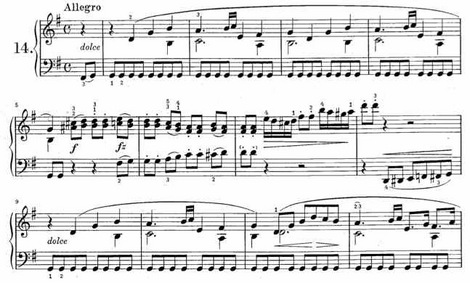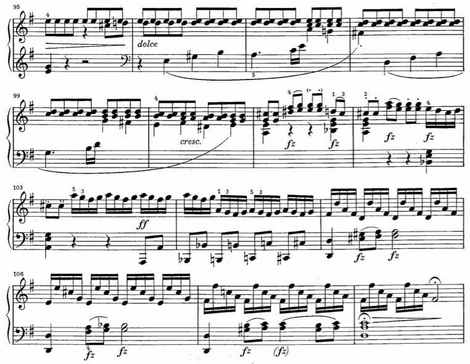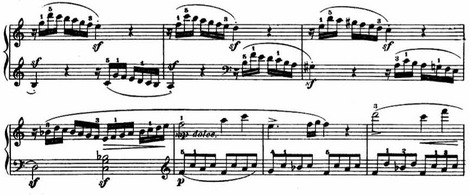is varied to become the second theme (and later inverted to become the closing theme):
It imparts to Clementi’s sonatas a lovely brand of introversion you don’t find in Mozart or Beethoven, a sense of the theme-hero being inflected according to its changing role in the sonata structure, and the whole movement being narrowly focused. I point this out to demonstrate how this particular sonata exhibits one of the cleverest strategies in leading to the recapitulation I’ve ever found. The development ends up on the dominant of A minor, and a modified form of the main theme emerges, moving ambiguously between e minor and G major, and finally reaching a dominant on G just in time for the second theme:
That means that, thematically, the piece arrives at the recapitulation thirteen measures before it reaches it tonally (i.e., a return to the tonic key), and uses the recapitulation of the main theme as its transitional element modulating back into the tonic. It’s an elegant structural pun, the theme serving to embody, hint at, and retransition to the recap all at once. Very smooth, very clever. Clementi clearly spent a lot of time thinking about the potential subtleties in sonata form and how to play around with them. There are many similar examples in his music (and Op. 37 No. 2 pales next to the six magnificent sonatas of his Op. 40 and Op. 50). And when you compare this level of structural thought and compositional rhetoric to the kind of awkward, slapdash transition that Mozart could jerry-rig in a now-famous sonata even as late as K. 545:
it’s clear that some of the excess idolatry we lavish on Mozart could aptly be retooled as honest admiration for Clementi, and for Jan Ladislav Dussek as well. Not that Clementi ever wrote anything that could match Mozart’s late piano concerti and operas (though he did provide Mozart with a theme for the Magic Flute overture), but it’s kind of silly and sad, given our far more complete view of the 19th century (except for the remarkable Franz Berwald) that we impart such a cartoonish, one-dimensional view of the classical era, just Haydn-Mozart-Beethoven with Gluck occasionally thrown in. Beethoven grew up with Clementi’s sonatas and borrowed from them, and I sometimes wonder what Ludwig thought of poor Clementi, a well-respected composer 19 years his senior, reduced to becoming Beethoven’s publisher and representative of his piano retailer. In my Evolution of the Sonata class, I try to correct the balance.
In Westminster Abbey a few years ago, I ran across Clementi’s grave by accident. (The English adopted him as they did Handel.) It was a thrill to run into someone whose music has given me so much pleasure.




